21st June 2021

Working out how many staff you need in a contact centre or BPO is a straightforward task, but it’s easy to make mistakes. A miscalculation can lead to long wait times, overworked agents, or unnecessary costs.
This guide breaks down the process into nine simple steps, helping you accurately determine staffing needs while avoiding common pitfalls.
We have condensed all the information that you need to make this headcount calculation into an easy-to-use, nine-step process, and we have also covered what you should NEVER do when making this calculation.
The first step in calculating your staffing headcount is to work out how many calls are coming into your business or BPO.
There are many ways in which you can work out the number of calls coming into the contact centre, but your method will depend on which sources of information you have access to and your call centre’s background. As there is a difference between inbound and outbound calls, the needs of your call centre will be different.
The following list considers this and presents you with a number of options that you can use to make the calculation.
If you cannot use any of the options listed above, you should make an estimate by following the procedure below.
Firstly, you will need to know the size of your customer base, the number of days your contact centre is open in a year and to make an estimation of the average number of times a customer will call each year.
For the example below, we have used the figures:
However, these calls won’t arrive evenly across the year.
Look back at your previous call volumes. Break down your annual call traffic into percentages which represent how much of this annual traffic you tend to get every month.
For example, in a retail contact centre you may see a workload pattern like the one in the table below.
| Month | Percentage of Calls |
|---|---|
| January | 14.07% |
| February | 5.19% |
| March | 4.51% |
| April | 6.15% |
| May | 4.79% |
| June | 6.83% |
| July | 6.43% |
| August | 9.84% |
| September | 6.43% |
| October | 7.93% |
| November | 10.58% |
| December | 17.25% |
| Total | 100.0% |
By doing this, you can estimate monthly contact volumes from your annual forecast.
Then, again looking back through your old contact volumes, take this one step further by looking at each month individually. Consider:
By asking these questions, you can split your monthly contact volumes into weekly contact volumes.
But we are not finished there. You will also notice that certain days of the week are busier than others. Typically, for instance, Monday is the busiest day in the contact centre.
So analyse what percentage of your weekly traffic falls on each day.
When you have done this, you can enter anticipated weekly contact volume, the number of hours you are open each day and those all-important percentages, into a trusty Erlang Calculator, like below.
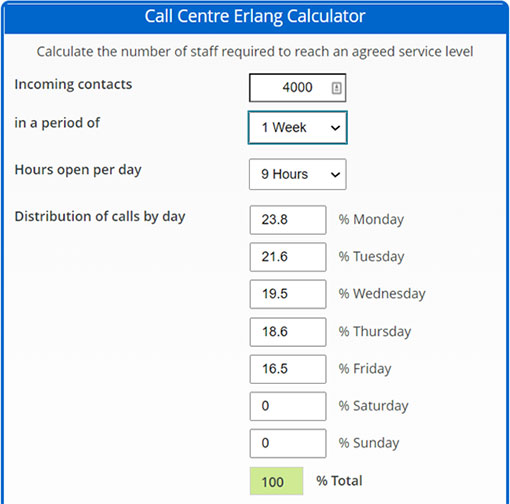
Yet to achieve even better results, try breaking your contact volumes down even further.
Apply these percentages to your weekly contact volume and calculate daily volumes. Then move on to Step 2.
For more guidance and more complex methods for predicting contact volumes, read our article: A Guide to Workforce Forecasting in the Contact Centre
Just as calls don’t arrive evenly throughout the week, they do not arrive evenly throughout the day.
So, use your forecast daily contact volumes – which you have calculated in the previous step – and forecast how many calls will arrive every hour or – better yet – 30 minutes.
There are two methods for doing this:
This is easily done if you have an ACD system or a Call Detail Report (CDR) for your call centre.
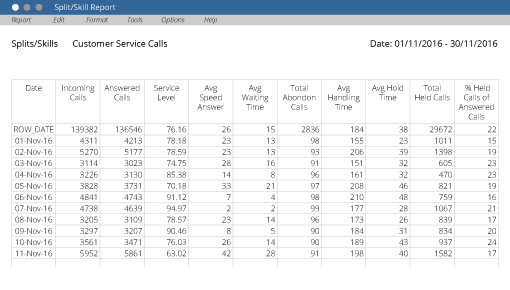
As you can see from the table above, your ACD system will be able to provide you with masses of information, including the number of calls that come into the contact centre over a defined period of time.
While the example given shows the daily report from the ACD system, it can also provide you with information for your desired time span. In this case, every half an hour or hour.
For more information on ACD systems, read our article: What to Look for When Buying an ACD System
If you don’t have access to the information above, you can make an accurate estimation. This is best done by using a call-arrival pattern similar to the one below.
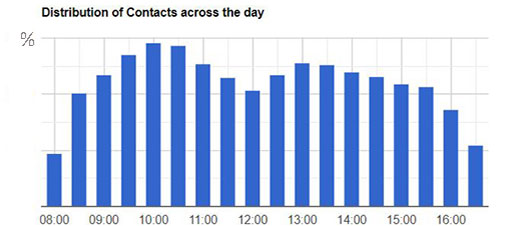
This pattern shows the profile of a contact centre’s demand across a typical day. You will need to create one of these for your contact centre.
To do this, analyse your contact volumes to find out what percentage of calls you receive across every half-hour or hour period on a typical day.
By doing so, you will create a set of results, just like in the table below:
| Time Interval | Percentage of Calls |
|---|---|
| 09:00 | 5.36% |
| 09:30 | 6.19% |
| 10:00 | 7.21% |
| 10:30 | 7.74% |
| 11:00 | 7.63% |
| 11:30 | 6.75% |
| 12:00 | 6.10% |
| 12:30 | 5.49% |
| 13:00 | 6.20% |
| 13:30 | 6.80% |
| 14:00 | 6.69% |
| 14:30 | 6.37% |
| 15:00 | 6.13% |
| 15:30 | 5.78% |
| 16:00 | 5.66% |
| 16:30 | 3.90% |
Use these percentages to create your call-arrival pattern and split your expected contact volumes for the day into 30-minute periods.
Average Handling Time (AHT) is the average amount of time that a contact centre advisor spends on a call. This can be averaged out across the entire contact centre.
To calculate your contact centre’s AHT, use the following formula:
Average Handling Time (AHT) = (Total Call Durations + Total Wrap Times) ÷ Number of Calls Handled

You can find each of the inputs through your ACD system and call centre reporting.
However, if this information is not available, the next best thing would be to time customer–advisor interactions, including hold time, total talk time and wrap time, in different circumstances.
When you have done so, you should then add all the times recorded together and then use the formula above. This calculated figure will represent your AHT.
The calculated number will vary depending on which sector of business your call centre represents. This is reflected in a Call Centre Helper poll, which showed a great difference between the AHT of different companies.
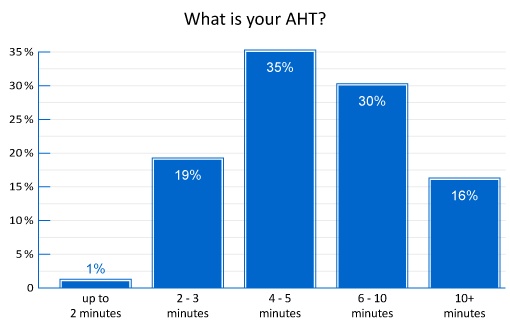
From this poll, we discovered that 4.9 minutes (294 seconds) was the median AHT for contact centres.
So, if the two options discussed above are not for you, you can use this value when moving through the steps below or you can use the AHT of the sector that is most relevant to you.
| Sector/ Scale of Business | Average Handling Time (Seconds) |
|---|---|
| Large Business | 522 |
| Telecommunications | 528 |
| Retail | 324 |
| Business & IT Services | 282 |
| Financial Services | 282 |
[The figures provided in this table come from a 2004 Cornell University report “U.S. Call Center Industry Report 2004, National Benchmarking Report, Strategy, HR Practices & Performance] – Rosemary Batt, Virginia Doellgast, Hyunji Kwon
However, whilst AHT is important in this scenario, try not to assess your advisors against it. This is because if your advisors are too eager to get the customer off the phone to meet their targets, then perhaps they are not providing great levels of customer service. This may also result in the customer calling back.
For the full guide on calculating AHT, read our article: How to Measure Average Handling Time
The industry standard for service level has historically been to answer 80% of calls within 20 seconds. However, modern contact centres are moving towards 90% of calls answered in 10 or 15 seconds.
Yet it would be impossible for your call centre to reach a target of 100% service level, as this would require an infinite number of advisors.
The graph below highlights how an alteration in service level will cause a change to the number of agents that you should employ.
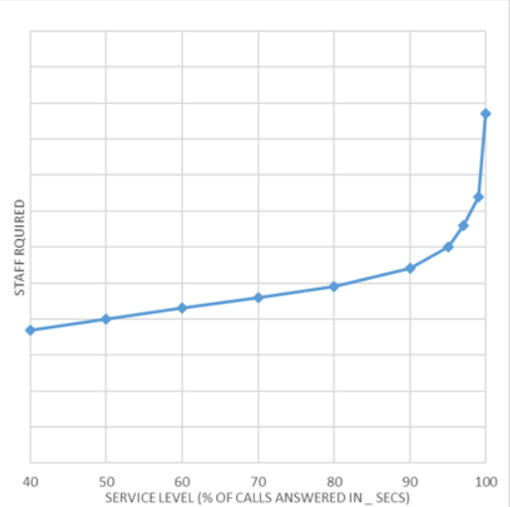
Ultimately, though, it is up to you to decide on a service level that keeps you competitive and does not involve recruiting too many advisors.
For more information regarding the typical service levels that contact centres target, read our article: What Are the Contact Centre Service Level Standards?
Now we have set a service level, we need to recognize that agents cannot spend 100% of their time on the phone for extended periods of time.
This is where occupancy, the amount of time agents spend on the phone over the course of the thirty minutes, comes in.
Maximum occupancy is often a factor that is ignored in the process of calculating how many agents you need in the contact centre. This doesn’t make any difference in a small contact centre but is a major factor in why so many larger contact centres are understaffed.
To understand whether you need to take occupancy into account, you first need to set an occupancy target, just as you would for service level.

Instead of the earlier stated 100% figure, James Barnes, Director of Destructive Digital, believes that most contact centres have a more realistic occupancy rate.
“On average, my clients’ maximum occupancy ranges from 85% (in-house) to 90% (more performance driven),” says James.
James’s clients would have set an occupancy rate target of 85-90% to find the ideal mix of productivity and achievability. A higher than 90% occupancy rate would likely lead to agents picking up undesirable behaviours on calls, succumbing to burnout or the contact centre having increased attrition rates.
But how do you know what your occupancy rate is?
To calculate occupancy, you simply divide the number of erlangs (traffic intensity) by the number of agents on the contact centre floor and then multiply it by 100 to obtain a percentage occupancy figure.
But if every contact centre has an occupancy rate, why does it matter for large contact centres and not for those that are smaller?
This is because, when call volumes increase, so does the number of calls an advisor has to take in 30 minutes, meaning that occupancy gets higher and higher. This increase in the “staff workload ratio” is highlighted in the table below.
| Traffic Intensity (Erlangs) | Number of Staff Needed to Meet Service Level | Average No. of Calls Per Advisor (Staff Workload Ratio) | Occupancy Rate (%) | No. of Calls per 30 Minutes |
|---|---|---|---|---|
| 8.7 | 12 | 8.3 | 72.5 | 100 |
| 43.6 | 49 | 10.2 | 89 | 500 |
| 87.2 | 94 | 10.6 | 92.8 | 1000 |
The figures in this table have been calculated using an AHT of 180 seconds and a target service level of answering 80% of calls in 20 seconds.
What they show us is that at 1000 calls, the occupancy rate is 92.8%, which, although we encourage agents to be productive, just is not realistic.
So, just like service level, set a target, which would usually be somewhere between 85-90%, which can be entered into the Erlang calculator.

The information gathered in the previous five steps will allow you to work out the raw number of advisors needed to answer the phones in the call centre, but it does not take shrinkage into account.
Shrinkage is the amount of paid time that an employee is not available to do productive work, such as answer phone calls, despite being scheduled to do so.
There is both internal call centre shrinkage – where an advisor is in the call centre but cannot answer the phone – and external shrinkage – which is when an advisor is out of the call centre due to sickness, holidays, emergencies etc. Both need to be factored in.
Generally, shrinkage in the call centre accounts for 35% of staff who are not using the telephone at any given time.
However, this is just an industry standard, and it is important for you to accurately calculate your shrinkage in order to provide a precise number for how many staff you need.
Also known as average time to abandon (ATA), average patience is the average length of time that a customer will stay in the queue before hanging up.
Many ACD systems will report on this figure but, for those unlucky few, the next best option is to create an abandon curve.
To do this, you will need to create a graph that plots the percentage of calls that abandon against time. An example is highlighted below.
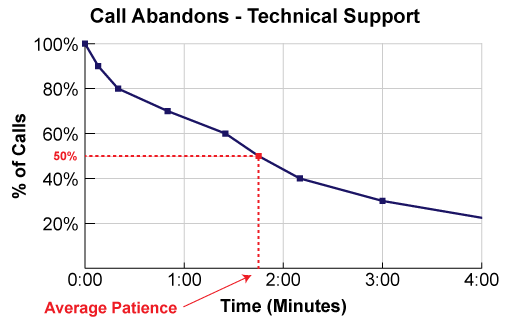
From this curve, you can spot the time within which 50% of your callers abandon. That time is your average patience.
This time is important, as – alongside, forecast contact volumes, AHT, service level, occupancy and shrinkage – it should be added into an Erlang Calculator to calculate the number of staff you need.
By completing each of the steps above, you will have collected lots of information, which you can enter into our Online Erlang Calculator.
Call Centre Helper’s Erlang Calculator is better than most as it allows you to determine how many call centre advisors you need during each 30-minute period of the day, with specific reference to shrinkage, occupancy and average patience.
The example below shows the number of advisors calculated by our Erlang Calculator when:
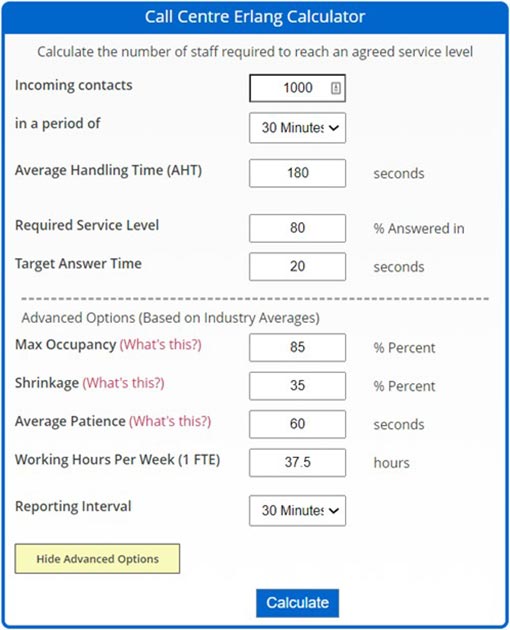
In this example, the Erlang Calculator determines that 182 agents should be deployed.
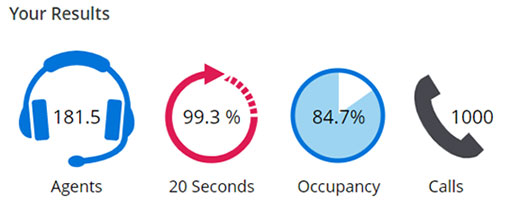
By doing this for every reporting period across the days, you can work out your daily headcount and start devising schedules to best meet demand.
If you would prefer to calculate staffing numbers in an Excel spreadsheet, we also have an Excel Based Erlang Calculator, which is very popular.
While it is important for you to match the call-arrival pattern with the number of advisors available to answer the phones, it would be implausible to hire staff for 30-minute periods every day.
In order to match advisors against call volumes, there are a number of ways to ensure that you have an optimum level of advisors working in your contact centre. These include:
Adding a day planner to your staffing calculations, with help from the Erlang Calculator – Day Planner, will help you manage this.
If you do this successfully, you will always have the optimum number of staff in your contact centre and they will be blocked around the call-arrival pattern, like in the graph below.
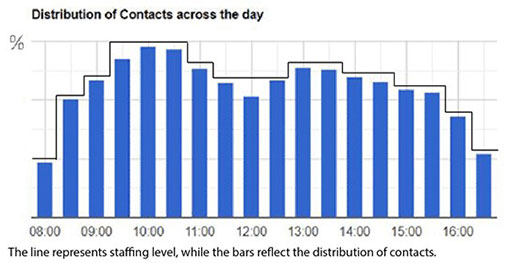
As you can see from this example, calls will tend to build up between 8am and 10am, with the busiest period of the day being from 10am to 12pm. This gives contact centres the ideal opportunity to stagger the start of agent shifts at the start of the day.
There are also many other shift patterns that you can experiment with.
These include:
Experimenting with shift patterns like this, you can determine the best way to meet demand in your own contact centre.
To discover even more shift patterns that you can implement in your contact centre, read our article: The Best Shift Patterns for the Contact Centre
It is very important that you avoid the most common mistake in calculating staff numbers, because if you do not, you will be severely understaffed.
This mistake involves dividing the total number of call minutes by the number of hours in a day.
For this example, we have used the figures:
The process then follows as so:
However, this method does not consider factors such as:
So, please avoid this method at all costs and instead follow our nine-step process above.
For more insights on staffing the contact centre, be sure to read our article: 10 Things You Must Know to Calculate How Many Contact Centre Advisors You Need
If you’re looking for more information on call centre staffing, read these articles next:
Reviewed by: Hannah Swankie